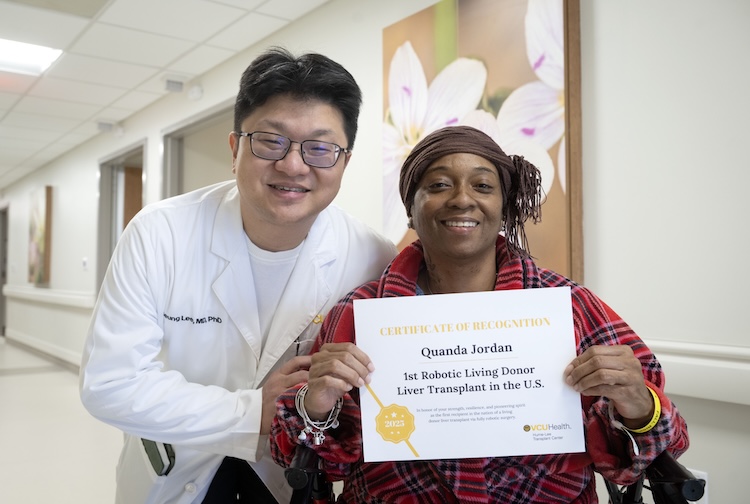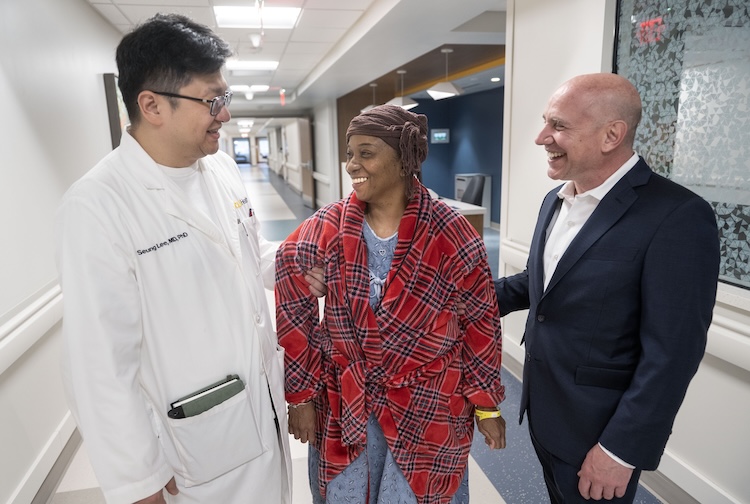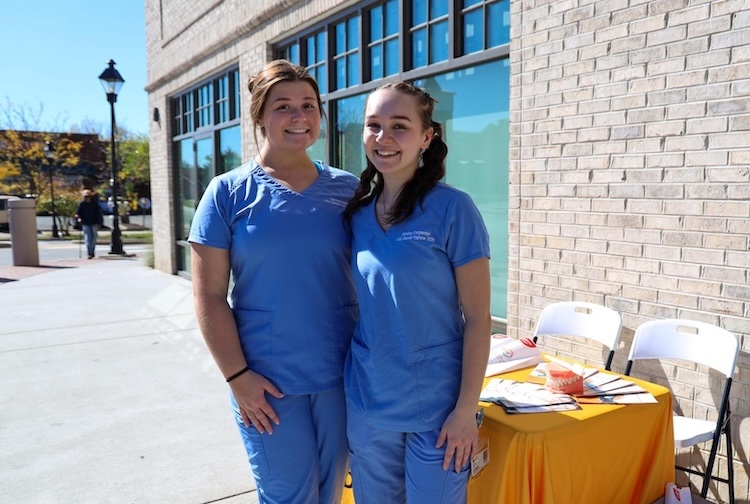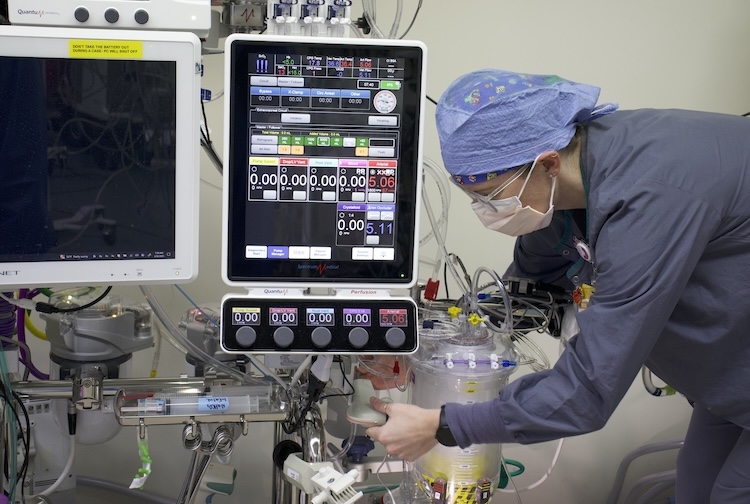How a teacher’s living liver donation changed a life – and U.S. transplant history
VCU Health Hume-Lee Transplant Center marks milestone with the first fully robotic living-donor liver transplant in the United States.
October 08, 2025 Seung Duk Lee, M.D., Ph.D., surgical director of liver transplant, poses proudly with his patient Quanda Jordan during her recovery at VCU Health Hume-Lee Transplant Center. (Kevin Morley, Enterprise and Marketing Communications)
Seung Duk Lee, M.D., Ph.D., surgical director of liver transplant, poses proudly with his patient Quanda Jordan during her recovery at VCU Health Hume-Lee Transplant Center. (Kevin Morley, Enterprise and Marketing Communications)
By John Battiston
Earlier this year, Quanda Jordan found herself at the center of history when she received the nation’s first fully robotic living-donor liver transplant at VCU Health Hume-Lee Transplant Center.
The Roanoke woman’s journey to that milestone was long and emotionally taxing. It began in the summer of 2024, when unexplained symptoms set her on a months-long search for answers, beginning at a local clinic.
“The nurse came back, and she said, ‘Something's attacking your liver. We see it, but we don't know what's going on,’” she recalled.
For weeks, Quanda bounced between appointments with providers, but the cause of her illness remained elusive. Between multiple emergency room visits, countless tests and disparate diagnoses from different doctors, frustration mounted for her and her family.
Finally, in January 2025, Quanda was sent to VCU Health’s comprehensive transplant center. It was a turning point.
“They knew what was wrong with me in less than 24 hours,” she said. “I’ve never felt so safe.”
Database of living liver donors becomes an unexpected lifeline
The diagnosis was rare: a one-in-a-million autoimmune disease known as anti-SLA subfulminant autoimmune hepatitis. Soon after, Quanda ’s care team delivered news that would change her life again: She had a donor.
“My family was going to start testing for a match, so to learn there was someone out there willing to give me part of their liver, sight unseen, shocked and amazed me,” she said.
That donor was Rick Ridpath, a middle school teacher from Colonial Heights. He had already donated a kidney years earlier after being inspired by his wife Tracey’s own kidney donation.
Despite the challenges that come with donating part of one’s liver — particularly a lengthy recovery — Rick felt called to become a repeat donor during a church event honoring organ donors like himself.
“I sat down in the pew, and I had this overwhelming feeling of, ‘Wait a minute, why not me?’” he said, adding that he faced the surgery without hesitation. “I wasn't nervous at all. It was just that feeling of, this is what I'm called to do.”
When it comes to living liver donation, there isn’t a national database to join. When someone steps forward as an “altruistic” donor—meaning they’re not matched to a specific patient—it’s usually because they’ve reached out to Hume-Lee Transplant Center with a desire to help.
Once approved, matching a donor to a recipient involves careful review by the transplant team. Providers consider factors like blood type, age, and body size, and then surgeons and hepatologists work together to determine the best possible match from the waitlist.

From left to right Seung Duk Lee, M.D., Ph.D., Quanda Jordan, and David Bruno, M.D., FACS, director of Hume-Lee Transplant Center. (Kevin Morley, Enterprise and Marketing Communications)
Robotic technology creates paradigm shift for liver transplant surgeries
Quanda’s operation was led by Seung Duk Lee, M.D., Ph.D., Hume-Lee's surgical director who heads one of the nation’s top ten liver transplant programs. Hume-Lee began using robotic devices for kidney transplantation nearly a decade ago, and added this technology for liver transplants in recent years.
Using robotic surgical systems for liver transplantation — a much more complicated and precise operation compared to the more common kidney transplant — marks a new paradigm shift. Hume-Lee surgeons conducted robotic hepatectomies on living liver donors for two years before they were ready to move on to the recipient side.
“This kind of robotic surgery was already performed in South Korea and Saudi Arabia, but never in the United States or even the Western Hemisphere,” Lee said. “When the opportunity came, I was pretty excited. This is my dream surgery. I’ve been working to achieve this operation for almost my entire life.”
While the procedure is difficult, the benefits for the organ recipient are significant: a small incision, better cosmetic results and a faster recovery. These outcomes are made possible by cutting edge equipment — specifically the new da Vinci 5 surgical system — and a dynamic team of dedicated health care professionals.
“There were two surgeons for both the donor and the recipient, anesthesiologists, hepatologists, nursing staff, transplant coordinators and the support staff — all working toward one vision,” Lee said. “This surgery was a success because of the entire team.”
Only a day after the operation, Quanda was already regaining her strength. “I was up walking, and I didn't feel a lot of pain,” she said. “I probably would have felt a lot more pain if the surgery was done the normal way.”
Quanda’s quick recovery affirmed for Lee what is possible in the years ahead. “I believe robotic surgery is the future,” he said. “Our vision is to expand access to living donor liver transplantation and to continually refine robotic techniques to make this operation even safer.”
Lee hopes the milestone inspires more people to consider organ donation. “One donor has the power to transform lives,” he said. “This is about saving lives and giving families hope.”
A lifelong connection made through the gift of life
Two weeks after Quanda’s operation, Rick received a phone call while he was drawing in his home studio. Despite not recognizing the number, he picked up.
“The caller said, ‘My name is Quanda, and I have part of your liver,’” he said. “She just kept saying, ‘Thank you so much. You are my hero.’ I didn’t do it to be called a hero, but to hear those words, you don’t take that lightly. I’ll never forget it.”
Quanda and Rick have maintained their virtual connection ever since, exchanging messages and photos of their families. They have yet to meet in person.
“He’s got a beautiful soul,” Quanda said. “I’ve got a piece of his liver, so I’ll always be connected with him. It’s just amazing — the human body, and how you can use yours to save someone’s life.”
Read more about our patients and providers




